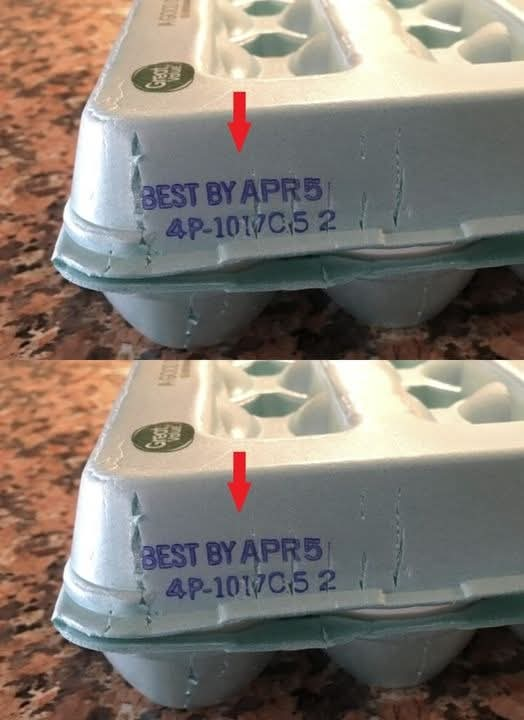A couple of years ago, I decided to show off my cooking skills at a small dinner party with a homemade egg casserole. Big mistake. Everyone ended up with upset stomachs—not hospital-level bad, but enough to make me feel like a terrible host. The eggs I used looked and smelled fine, and they were within the expiration date. So what went wrong? Turns out, I’d ignored a small but crucial detail: the three-digit code on the side of the egg carton.
That code, known as the Julian date, shows the exact day of the year the eggs were packed. For instance, “010” means January 10th, and “200” is July 19th. It’s a better way to gauge freshness than the sell-by date, which can be confusing. Since that dinner disaster, I’ve turned into that person at the store, carefully checking cartons for the most recent Julian date—preferably within the last two weeks. I might look a bit obsessive, but I’m not risking another culinary flop.
You’ll also notice a code starting with a “P” on the carton. That’s the plant code, showing where the eggs were processed. I didn’t think much of it until a salmonella recall had me glued to my phone, cross-referencing my eggs with online recall notices. Luckily, mine were fine, but now I always check the plant code. I used to rely on the “float test”—put an egg in water, and if it floats, it’s bad; if it sinks, it’s good. It’s a fun trick, but the Julian date is way more reliable.
Now I scribble notes on my cartons, like “Packed Day 140, Use by Day 170,” to keep things organized. Storing eggs in the coldest part of the fridge, not the door, also keeps them fresher longer. And those labels like “Cage-Free,” “Free-Range,” or “Pastured”? They’re not all equal. “Cage-free” hens might still be in crowded barns, and “free-range” often means minimal outdoor access. “Pastured” eggs come from chickens that actually roam outside, and their yolks are so rich and orange they make every dish pop.
Then there’s the USDA grading—AA, A, or B. Grade AA eggs are top-notch with firm whites and high yolks, great for sunny-side-up eggs. Grade A is solid for baking or scrambling, and Grade B is hardly ever seen in stores. I once made an omelet with eggs over a month past their pack date—not expired, but old—and it was watery and tasteless. A week later, using fresh eggs, the same recipe was a dream. I’m now an egg fanatic, and I’m fine with it. Next time you’re at the store, don’t be shy about inspecting those cartons. Those numbers are your secret weapon for tastier meals and safer cooking.
A couple of years ago, I decided to show off my cooking skills at a small dinner party with a homemade egg casserole. Big mistake. Everyone ended up with upset stomachs—not hospital-level bad, but enough to make me feel like a terrible host. The eggs I used looked and smelled fine, and they were within the expiration date. So what went wrong? Turns out, I’d ignored a small but crucial detail: the three-digit code on the side of the egg carton.
That code, known as the Julian date, shows the exact day of the year the eggs were packed. For instance, “010” means January 10th, and “200” is July 19th. It’s a better way to gauge freshness than the sell-by date, which can be confusing. Since that dinner disaster, I’ve turned into that person at the store, carefully checking cartons for the most recent Julian date—preferably within the last two weeks. I might look a bit obsessive, but I’m not risking another culinary flop.
You’ll also notice a code starting with a “P” on the carton. That’s the plant code, showing where the eggs were processed. I didn’t think much of it until a salmonella recall had me glued to my phone, cross-referencing my eggs with online recall notices. Luckily, mine were fine, but now I always check the plant code. I used to rely on the “float test”—put an egg in water, and if it floats, it’s bad; if it sinks, it’s good. It’s a fun trick, but the Julian date is way more reliable.
Now I scribble notes on my cartons, like “Packed Day 140, Use by Day 170,” to keep things organized. Storing eggs in the coldest part of the fridge, not the door, also keeps them fresher longer. And those labels like “Cage-Free,” “Free-Range,” or “Pastured”? They’re not all equal. “Cage-free” hens might still be in crowded barns, and “free-range” often means minimal outdoor access. “Pastured” eggs come from chickens that actually roam outside, and their yolks are so rich and orange they make every dish pop.
Then there’s the USDA grading—AA, A, or B. Grade AA eggs are top-notch with firm whites and high yolks, great for sunny-side-up eggs. Grade A is solid for baking or scrambling, and Grade B is hardly ever seen in stores. I once made an omelet with eggs over a month past their pack date—not expired, but old—and it was watery and tasteless. A week later, using fresh eggs, the same recipe was a dream. I’m now an egg fanatic, and I’m fine with it. Next time you’re at the store, don’t be shy about inspecting those cartons. Those numbers are your secret weapon for tastier meals and safer cooking.

